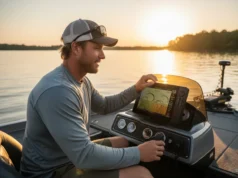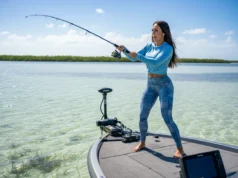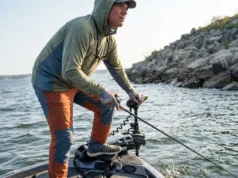In this article
The plastic creates a dull, reassuring thud as you drop a 50lb lead-acid battery into the bow hatch. On a cheap recreational hull, the waterline rises dangerously close to the gunwales, and the plastic floor flexes under your feet like a trampoline. On a purpose-built sit-on-top fishing kayak, the chassis settles firmly, displacing water efficiently, ready for the trolling motor you plan to mount next month.
The difference between a regrettable purchase and a long-term investment in this price bracket isn’t the number of flush mount rod holders bolted on at the factory. It is the structural integrity and “Mod-Readiness” of the high-density polyethylene shell itself. At the sub-$1000 price point, you are not purchasing a finished luxury vessel; you are investing in a structural chassis.
In my years guiding on both salt and fresh water, I’ve seen budget fishing kayaks crack under stress and “bargain” seats cripple anglers’ backs. The true value lies not in stock accessories, but in the hull’s engineering capacity to accept aftermarket modifications—motors, advanced fish finders, and anchoring systems—without structural failure. This guide moves you from the confusion of flimsy recreational kayaks like the Sun Dolphin Boss 10 SS to the confidence of selecting a “Mod-Ready” hull that scales with your skills.
How to Choose the Right Fishing Kayak Chassis
Marketing departments love to sell features, but engineers build chassis. To make a smart choice, you need to ignore the fluff and look at the physics of these paddle-driven kayaks.
Stability Mechanics: The Primary vs. Secondary Trade-off
Stability is often marketed as a single metric, but it is actually a relationship between two opposing forces. You cannot have maximums of both; you must navigate the stability vs speed trade-off based on your water type.
- Primary Stability (The “Dock” Feel): This is the high resistance to tipping on flat water. It is achieved by flat bottoms or pontoon/tunnel hulls. While ideal for stand-up capable platforms and sight casting, these hulls suffer from “hull slap” and significant drag.
- Secondary Stability (The “Seaworthy” Feel): This is the hull’s ability to resist capsizing when tipped on its edge. Achieved by rounded or V-shaped chines, it feels “twitchy” initially but handles boat wakes and rough water safely.
Stability keeps you upright, but safety goes beyond just the hull shape—it’s about preparation and essential gear like the non-negotiable Personal Flotation Device (PFD). According to the ABYC H-29 Standards, capacity ratings are calculated based on displacement, but they don’t account for the dynamic shifts of an angler reeling in a fish.
Material Composition: Rotomolded HDPE vs. Thermoformed ABS
Not all plastic is created equal. The manufacturing process dictates how you can—and cannot—modify your boat.
- High-Density Polyethylene (HDPE): This is the industry standard found in Made in USA brands like Jackson Kayak, Native Watercraft, and Old Town. It is heavy, abrasion-resistant, and possesses a waxy, “self-healing” quality. Crucially, it is the best material for drilling and screw retention.
- Thermoformed ABS: Found in kayaks like the Pelican Catch 120 or the RAM-X series, this material is lighter, stiffer, and faster. However, it is significantly thinner. As detailed by U.S. DOE polymer explanations, the molecular structure differs; practically, this means screws will rip out of the thin skin under load unless you use internal backing plates.
Understanding the hull weight and density is the first step in determining the car-topping reality. There is a direct penalty: durability (plastic thickness) equals weight.
The “Mod-Ready” Index (MRI)
Once you have a hull that can support hardware, the most common first upgrade is propulsion. You need to assess the hull for:
- Internal Access: Can you reach inside the hull? You need storage hatches to install backing plates for motors or anchor trolleys.
- Transducer Protection: A recessed transducer scupper is superior to over-the-side arms for sonar installation, protecting your sensor from rocks.
- Flat Surfaces: Flat gunwales allow for easy mounting of gear tracks (YakAttack/Scotty), whereas rounded surfaces on imported brands often resist modification.
Proper hull access allows you to securely install hardware and eventually pick the best trolling motor for your boat without fear of the mount flexing the plastic. Effective launch design guidelines suggest that heavier, modified boats require specific considerations for entry and exit, further emphasizing the need for a robust chassis.
Our Selection Process: How We Built This Guide
Trust is built on transparency. We ignore marketing jargon and focus strictly on the “Modification Potential” of the bare hull.
Our evaluation framework rates every kayak on Stability Profile, Material Density, and Internal Access for Rigging. We filtered out generic big box options like the Lifetime Tamarack Angler 100 or Magellan Outdoors Pro Angler that lack the structural integrity for motors or heavy electronics, focusing strictly on specialized fishing platforms. While we may earn a commission, our recommendations are driven by data and hull performance, not payout rates.
Pro-Tip: When inspecting a kayak in person, open the front hatch and hold a flashlight against the outside of the hull. If the light shines through brightly and you can see thin spots, that plastic is too thin for heavy accessories.
The Best Fishing Kayaks of 2026: Our Top Recommendations for Every Need
Our Top Picks for The “Stand-Up” Specialist
Our Top Picks for The “Touring” Tactician
Our Top Picks for The “River” Specialist
Conclusion
Choosing the right hull is about understanding the physics of your fishery. Stability is a curve, not a single number; flat hulls like the Perception Outlaw serve stand-up capable anglers, while rounded hulls handle the rough stuff. Material matters just as much, with Rotomolded HDPE standing as the only real choice for heavy DIY drill-and-tap modifications.
The hidden cost of budget boats often reveals itself in necessary upgrades, like seat risers or rudders, to match performance. The sweet spot lies in the $900–$999 range, where brands like Old Town and Vibe offer chassis that retain value and resist abuse.
Stop buying disposable gear like the Lifetime Yukon Angler expecting a lifetime of service. Select the chassis that matches your water, plan your rigging roadmap, and build a vessel that becomes an extension of your angling will.
FAQ – Frequently Asked Questions
Can I put a trolling motor on a kayak under $1000?
Yes, specifically on hulls with reinforced transoms like the Perception Outlaw or Ascend 12T. However, you must factor in the weight of the battery and motor against the kayak’s usable payload (Total Capacity minus Boat Weight minus Your Weight). If you want hands-free fishing without a motor, look for a budget pedal drive kayak like the Riot Mako 10.
Is a sit-on-top or sit-inside kayak better for fishing?
Sit-on-top fishing kayaks are universally superior for fishing due to self-bailing scuppers (safety) and open decks for gear access. Sit-inside kayaks are dangerous if swamped and offer limited rigging space.
Do I need a rudder on a 10-12 foot kayak?
For paddling long distances or drift fishing in wind, a rudder system is essential to prevent weathercocking (turning into the wind). The Vibe Sea Ghost 110 includes one, while others may require a $200+ aftermarket install.
How do I mount a fish finder if I don’t want to drill holes?
Look for kayaks with scupper mount compatibility (like Vibe) or utilize accessory rails (like the YakAttack SwitchBlade) that mount to factory gear tracks. Alternatively, use a shoot-through-hull installation with duct seal putty for 2D sonar on single-layer hulls.
Risk Disclaimer: Fishing, boating, and all related outdoor activities involve inherent risks that can lead to injury. The information provided on Master Fishing Mag is for educational and informational purposes only. While we strive for accuracy, the information, techniques, and advice on gear and safety are not a substitute for your own best judgment, local knowledge, and adherence to official regulations. Fishing regulations, including seasons, size limits, and species restrictions, change frequently and vary by location. Always consult the latest official regulations from your local fish and wildlife agency before heading out. Proper handling of hooks, knives, and other sharp equipment is essential for safety. Furthermore, be aware of local fish consumption advisories. By using this website, you agree that you are solely responsible for your own safety and for complying with all applicable laws. Any reliance you place on our content is strictly at your own risk. Master Fishing Mag and its authors will not be held liable for any injury, damage, or loss sustained in connection with the use of the information herein.
Affiliate Disclosure: We are a participant in the Amazon Services LLC Associates Program, an affiliate advertising program designed to provide a means for us to earn advertising fees by advertising and linking to Amazon.com. As an Amazon Associate, we earn from qualifying purchases. We also participate in other affiliate programs and may receive a commission on products purchased through our links, at no extra cost to you. Additional terms are found in the terms of service.





